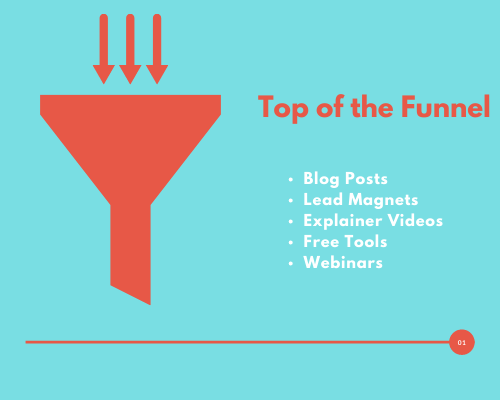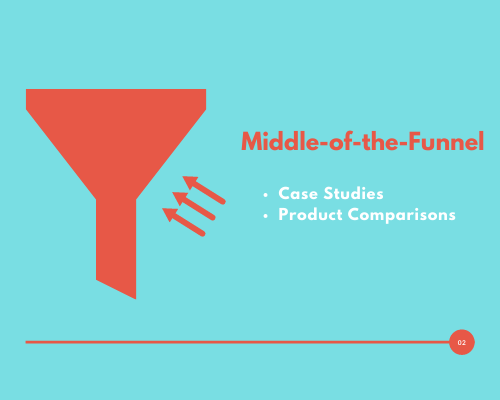We often see content as a way to bring in traffic at the top of the funnel, but it’s a lot more than that.
Content marketing has a big part to play at every step of the sales funnel. Indeed, a SEMrush study found that:
- 95% of marketers create top-of-the-funnel (TOFU) content
- 86% create middle-of-the-funnel (MOFU) content
- 76% create bottom-of-the-funnel (BOFU) content
So while there’s a slight bias towards creating awareness-stage content, a significant proportion of marketers are also using content further down the funnel, at the consideration and decision-making stages.
Clearly, each of those stages requires very different content. A prospect who’s just identified a need won’t be searching for the same information as one who’s ready to convert.
With that in mind, here’s how to write content for each stage of the sales funnel.
Top-of-the-Funnel: Awareness
Typically, the buyer’s journey begins at the very top of the funnel. This might not be the case in an industry like ecommerce, where impulse buys are common, but it’s almost always true for any B2B business.
At this stage, the prospect has experienced some kind of event that causes them to search for a solution. Maybe they’re churning too many customers, or their revenue is too low, or they’re unprofitable.
Importantly, they likely know little or nothing about your brand at this point. You need to target them through content that speaks to their business challenges and offers a solution.
Effective TOFU Content Types
1. Blog Posts
Blogging is the bread and butter of your content marketing strategy. More than half of marketers list blogging as their top priority – and for good reason, because marketers who prioritize blogging generate 13 times more ROI than those who don’t.
Blogs give you an opportunity to speak directly to the pain points and business goals of your ideal prospects. What’s more, they allow you to deep-dive into these topics, with HubSpot data revealing that the ideal blog post length from an SEO perspective is now between 2,100 and 2,400 words. That’s certainly long enough to discuss most subjects in a certain amount of depth.
Incorporating relevant keywords in your blog content will help you bring in traffic through organic search – but that’s not the only channel you should be targeting. Your blogs should also be amplified through social (organic, paid, or both), email marketing by using software like Mailchimp, and potentially even paid search.
2. Lead Magnets
While blogs are useful for generating brand awareness, lead magnets are your opportunity to top up your sales pipeline with prospects’ names and contact details.
Lead magnets come in many forms. The classic example is a downloadable asset like an ebook or infographic, but there are lots of other types. For instance, this blog on app development gives out a Sprint Plan Template as a downloadable asset.
In fact, video-based lead magnets actually have a slightly higher conversion rate than written content (24.2% vs. 22.8%), while visual content – like infographics – and free tools both convert at a rate of 11.8%.
Whatever lead magnet type works best for your brand and prospects, it’s important that you offer something that can’t be found anywhere else. That uniqueness will compel people to hand over their email addresses and phone numbers.
3. Explainer Videos
It may seem counterintuitive to explain to prospects how to solve their problem themselves, but explainer videos are actually very effective at the top of the funnel, with 53% of marketers agreeing that video helps them raise awareness. They work for several reasons:
- You can explain how your product is a key part of resolving the prospect’s pain point
- Your audience may not understand the true value of your product until they’ve tried to tackle the problem themselves
- The fact you’re prepared to explain how to solve your prospect’s problems demonstrates you’re credible and trustworthy
Beyond this, it’s worth noting that video content performs extremely well on social, helping you get more eyes on your content. Indeed, video sees higher engagement rates on Facebook than any other content type, at 6.13%.
4. Free Tools
If you have the capability to build a free tool that helps your prospects solve a problem they’ve just identified, it can play a key part in your sales process, because those prospects will come back to it time after time.
You don’t necessarily need to create your tool from scratch. It could simply offer a tiny part of the functionality of your actual product. For instance, Ahrefs offers a free backlink checker that allows users to see how many links are pointing at a given domain or URL, but doesn’t provide any of the other analytical tools that are part of the full Ahrefs package.
By building a genuinely useful free tool, you can ensure that your brand is front of mind when your prospects are closer to making a purchase decision.
5. Webinars
Webinars are an increasingly popular top-of-the-funnel content type, with 53% of marketers planning to include them in their 2021 video marketing strategy, up 11% on the previous year.
That’s hardly surprising, because three-quarters of B2B marketers and sales leaders say webinars help them bring in high-quality leads.
What makes webinars so effective?
When it comes to live webinars, the interactive element is a key differentiator. Whereas ebooks and videos are a one-way conversation, live webinars allow your prospects to ask questions that you can answer in real time. This means they’re a fantastic way to build trust in your brand.
Middle-of-the-Funnel: Consideration
You’ve grabbed your prospect’s attention; now they’re ready to move into the middle of the sales funnel.
At this point, prospects understand that they have a problem that needs solving, and they have an idea of what the solution might look like. Now, they want to track down the right solution.
As such, while the top of the funnel is all about educating your prospects, this stage – known as the consideration stage – involves demonstrating why your product has the answer to their problems.
Effective MOFU Content Types
1. Case Studies
One in eight marketers cite case studies as one of main elements of their content strategy, making them the fifth most popular content type overall, behind only blogs, videos, infographics, and ebooks.
Case studies are your chance to explain specifically how your product has overcome similar challenges to those faced by your prospect, and at similar types of organization.
However, that doesn’t mean they’re simply a description of features and benefits.
Instead, effective case studies tell a story, setting out the pain points faced by one of your customers, explaining why they chose your product, and detailing the results they saw. Done well, a case study should enable your prospects to picture themselves facing the same scenario, making the same decisions, and achieving the same goals.
2. Product Comparisons
The middle of the funnel is known as the consideration stage for a reason – your prospect is likely considering several different options.
As such, comparison pieces – in other words, content that weighs up the strengths and weaknesses of your product against those of your competitors – are highly valuable at this stage.
Clearly, you’re biased. It’s unlikely that you’re going to say: “My product is definitely worse than my biggest rival’s product.” But you can still offer a degree of objectivity.
Try setting out why your product is right for your specific ideal buyer. For instance, if your solution is aimed at fast-growing businesses, whereas your rivals focus on enterprise-level, you can speak to its flexibility and scalability. And because you’re not targeting enterprises, it’s fine for you to say that your competitors’ products are better suited to those types of businesses.
Bottom-of-the-Funnel: Decision-Making
When they reach the bottom of the sales funnel, your prospect is ready to make their purchase decision.
Of course, that doesn’t mean they’re definitely going to buy from you. But you’re certainly in the running.
Typically, leads at this stage need a little gentle persuasion to get them over the line. The right content, combined with a compelling call to action, can make all the difference.
Effective BOFU Content Types
1. Free Trials
Free trials allow prospects to test drive your product. Particularly popular in the SaaS sales, they typically come in one of two flavors:
- Time-limited: The prospect has full access to your product for a set period.
- Capability-limited: The prospect can use a limited selection of your product features for as long as they want.
Either way, the hope is that once they’ve enjoyed some or all of your feature set, your prospect will be desperate for more – and willing to pay for it.
2. Product Demos
Free trials are great, but they’re not right for every brand.
If your product is simply too complex for a prospect to learn on their own, or takes a month or more to start demonstrating value, a free trial likely isn’t going to work for you. In that case, a product demo is a better bet.
Much like free trials, there are two main types of product demo:
- Live demo: A salesperson will talk the prospect through relevant features and benefits of your product, answering questions and handling objections on the fly.
- Video demo: The prospect watches a video explaining key product features.
In some cases, your prospect might watch a video demo, then request a more in-depth live demo.
3. Free Consultations
Of course, not all companies have a product. If you’re a service-based business, a free consultation is a good substitute for a product demo or free trial.
Consultations work best when they offer the prospect something of real value. Marketing agencies use this tactic a lot. They might produce a free SEO audit of a prospect’s website, or build a content strategy.
Naturally, you don’t want to give away everything for nothing. Whatever you produce, it should provide enough depth to be useful, while still giving the prospect a clear need for your service.






 (1 votes, average: 4.00 out of 5)
(1 votes, average: 4.00 out of 5)